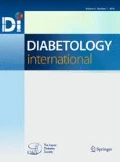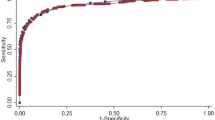Abstract
Using data on health checkups performed in one Japanese town, we investigated the effect on health checkups of the methods used to measure hemoglobin A1c (HbA1c). The study included 337 participants undergoing health checkups at two facilities. At facility 1, HbA1c was measured by high-performance liquid chromatography (HPLC) in 2012 and by immunoassay (IA) in 2013, while at facility 2, HbA1c was measured by HPLC in both years. At facility 1, the mean HbA1c was significantly decreased from 2012 to 2013 (5.83 vs 5.50 %, respectively; P < 0.001), although the mean fasting plasma glucose (FPG) was significantly increased from 2012 to 2013 (91.7 vs 95.2 mg/dL, respectively; P = 0.02). Of the 202 participants at facility 1, 97 who had an HbA1c of ≥5.6 % in 2012 had an HbA1c of <5.6 % in 2013. At facility 2, the mean HbA1c marginally increased, while there were similar FPG levels in both years. An additional study of single blood samples from 27 healthy participants who were tested at the same facility using both HPLC and IA found that the mean HbA1c was significantly lower for IA than for HPLC (5.19 vs 5.50 %, respectively; P < 0.001). In summary, we found a substantial decrease in the mean HbA1c and the prevalence of impaired glucose tolerance and diabetes mellitus in study participants who underwent health checkups for two consecutive years when different methods were used to measure HbA1c. The lack of standardization of HbA1c measurement methods may have a large effect on health checkups.
Similar content being viewed by others
References
Nathan DM, Buse JB, Davidson MB, et al. Management of hyperglycemia in type 2 diabetes: a consensus algorithm for the initiation and adjustment of therapy. Diabetologia. 2009;52:17–30.
Nathan DM, Turgeon H, Regan S. Relationship between glycated haemoglobin levels and mean glucose levels over time. Diabetologia. 2007;50:2239–44.
Nathan DM, Kuenen J, Borg R, Zheng H, Schoenfeld D, Heine RJ, A1c-Derived Average Glucose (ADAG) Study Group. Translating the A1C assay into estimated average glucose values. Diabetes Care. 2008;31:1473–8.
Committee of the Japan Diabetes Society on the Diagnostic Criteria of Diabetes Mellitus. Report of the Committee on the Classification and Diagnostic Criteria of Diabetes Mellitus. J Diabetes Investig. 2010;1:212–28.
Mizushima S, Tsushita K. New strategy of prevention and control of noncommunicable lifestyle-related diseases focusing on metabolic syndrome in Japan. In: Muto T, Nakahara T, Eun WN, editors. Asian perspectives and evidence on health promotion and education. Tokyo: Springer; 2011. p. 31–9.
Ministry of Health, Labour and Welfare of Japan. The basic guideline for health checkups and healthcare advice with a particular focus on the metabolic syndrome (final edition). Tokyo: Ministry of Health, Labour and Welfare of Japan; 2007 (in Japanese).
Nakanishi K, Ishida A, Mori N, et al. Evaluation of HbA1c by HPLC and immunoturbidimetry latex agglutination on calibrator JCCLS CRM-004a (JDS Lot3). Jpn J Clin Lab Autom JJCLA. 2009;34:233–6.
National Federation of Industrial Health Organization. An annual report of accuracy control surveillance for clinical laboratory test. http://www.zeneiren.or.jp/research_list/index.html Accessed 28 Sep 2015 (in Japanese).
Vogeser M, Parhofer KG. Head-to-head comparison of an automated immunometric and an automated HPLC method for the quantification of HbA1c. Clin Biochem. 2008;41:1410–2.
Imoto S, Kido T, Nakanishi S, Yamano C. HbA1 assay by auto clinical chemistry analyzer. Annu Rep Kyoto City Inst Health Environ Sci. 2005;71:118–9.
Matteucci E, Cinapri V, Rossi L, Lucchetti A, Giampietro O. Glycated hemoglobin measurement: intermethod comparison. Diabetes Nutr Metab. 2001;14:217–9.
Ishiguro A, Yamauchi T, Imada R, et al. Differences in hemoglobin A1c (HbA1c) levels due to measurement methods. Igakukensa. 2014;63:767–72 (in Japanese).
Health and Welfare Statistics Association. 2014/2015 Kokumin Eisei no Doko (Trend for national health and hygiene, Japan). Tokyo: Health and Welfare Statistics Association; 2014 (in Japanese).
Nakamura K, Miura K, Nakagawa H, et al. Treated and untreated hypertension, hospitalization, and medical expenditure: an epidemiological study in 314 622 beneficiaries of the medical insurance system in Japan. J Hypertens. 2013;31:1032–42.
Kashiwagi A, Kasuga M, Araki E, Committee on the Standardization of Diabetes Mellitus-Related Laboratory Testing of Japan Diabetes Society, et al. International clinical harmonization of glycated hemoglobin in Japan: From Japan Diabetes Society to National Glycohemoglobin Standardization Program values. Diabetol Int. 2012;3:8–10.
Acknowledgments
The authors express their sincere appreciation to the staff of the health centers of the target town for their generous cooperation.
Author information
Authors and Affiliations
Corresponding author
Ethics declarations
Conflicts of interest
J. Oikawa, K. Nakamura, S. Ukawa, T. Kishi, A. Nakamura, and A. Tamakoshi declare that they have no conflicts of interest.
Human rights statement and informed consent
The study was approved by the Ethics Committee of the Hokkaido University Graduate School of Medicine. All procedures followed were in accordance with the ethical standards of the responsible committee on human experimentation (institutional and national) and with the Helsinki Declaration of 1964 and later revisions. Informed consent was obtained from all study participants who were included in the additional study.
About this article
Cite this article
Oikawa, J., Nakamura, K., Ukawa, S. et al. Influence of different methods for measuring HbA1c on health checkups in a rural town in Hokkaido, Japan. Diabetol Int 7, 391–397 (2016). https://doi.org/10.1007/s13340-016-0263-1
Received:
Accepted:
Published:
Issue Date:
DOI: https://doi.org/10.1007/s13340-016-0263-1




